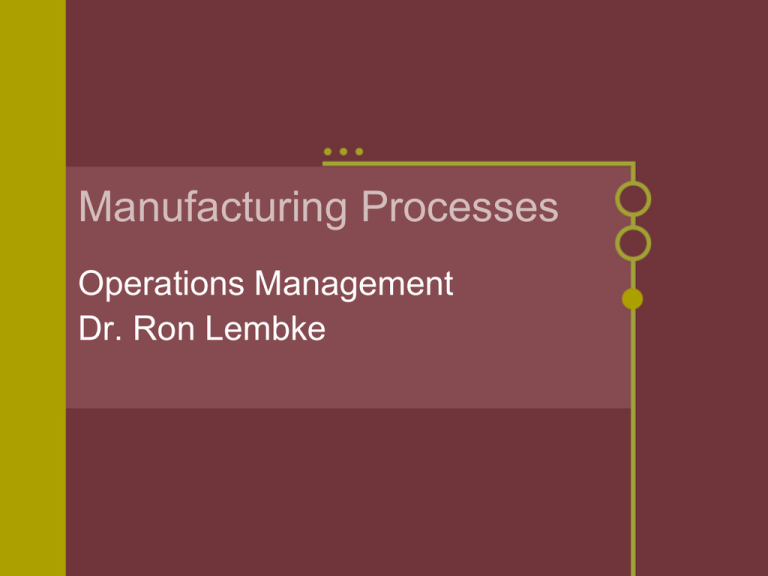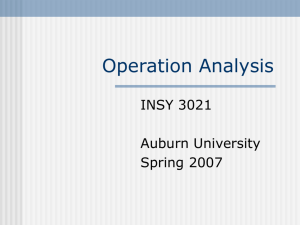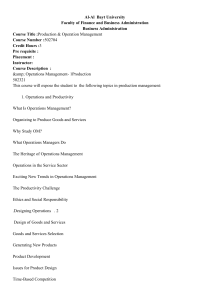Manufacturing Processes
advertisement

Manufacturing Processes Operations Management Dr. Ron Lembke Break-Even Analysis Given a fixed cost, how many do we have to make to break even? A: buy units @ $200 B: Make on lathe: $80,000 + $75 each C: Machining Center: $200,000 + $15 each Which is the cheapest way? Break-Even Analysis If we only sell 1, which is cheapest? If we sell a gazillion, which is cheapest? Total Costs Break-Even Outsource Draw Lowest Fixed Cost Line Volume Total Costs Break-Even Outsource Lathe Machining Center Volume Total Costs Break-Even Outsource Lathe Machining Center Volume Total Costs Break-Even Outsource Lathe Machining Center Volume Break-Even Analysis Total Costs Cost of 1,000 units A: 200 * 1,000 = 200,000 B: 80,000 + 75*1,000 = 155,000 C: 200,000 + 15*1,000 = 215,000 300k 200k C A B 100k Volume 1,000 Break-Even Analysis Cost of 2,000 units A: 200 * 2,000 = 400,000 B: 80,000 + 75*2,000 = 235,000 C: 200,000 + 15*2,000 = 230,000 Total Costs 400k 300k A B C 200k 100k Volume 2,000 Break-Even Analysis Cost of 2,000 units A: 200 * 3,000 = 600,000 B: 80,000 + 75*3,000 = 305,000 C: 200,000 + 15*3,000 = 245,000 Total Costs 600k A 500k 400k 300k B C 200k 100k Volume 3,000 Total Costs Break-Even Outsource Lathe Outsource Lathe Machining Center Machining Center Volume Break-Even Analysis When does Lathe become cheaper? 80,000 + 75*x = 200*x 80,000 = 125*x x = 640 Total Costs Break-Even Analysis Outsource Lathe Outsource Lathe Machining Center Machining Center 640 Volume Break-Even Analysis When does Machining Center become cheaper? 80,000 + 75*x = 200,000 + 15*x 120,000 = 60*x x = 2,000 Total Costs Break-Even Analysis Outsource Outsource Lathe Lathe Machining Center Machining Center 640 2,000 Volume Break-Even Analysis How much do sales have to grow to make an investment pay off? Fixed costs = $10,000 Direct labor = $1.50 / unit Material = $0.75 / unit Sales price = $4.00 How many units must sell to break even? Break-Even Analysis How to measure the value of a dollar saved tomorrow? Can you say “Net Present Value?” Break-Even Analysis How to measure the value of a dollar saved tomorrow? Can you say “Net Present Value?” I knew you could. Process Flow Structures Job Shop - low standardization, every order is a different product, new design Batch Shop - Stable line of products, produced in batches Assembly Line - Discrete parts moving from workstation to workstation Continuous Flow - Undifferentiated flow of product (beer, paper, etc.) Process Strategy Variety High Medium project Workcenter Manufacturing Cell Assembly Line Continuous Process Low Low Medium High Volume Process Strategy Variety High Process Focus (job shops) Repetitive (cars, motorcycles) Medium Product Focus (steel, glass) Low Low Medium High Volume Process Focus (Job Shop) Low volume, high variety, “do it all” “Job shop” environment (e.g. Kinko’s) High amount of flexibility Each job is different Relatively high cost per unit Very high flexibility Process Selection / Evolution Products tend to move through the four stages over life cycle. Unit costs decrease as standardization increases, and production increases. Flexibility decreases as volume, standardization increase Design for Manufacturing -Before Design for Manufacturing-After Designing the System How do we decide where to put things? Layout Types Project or Fixed-position layout Process-oriented layout Product-oriented layout Office layout Warehouse layout Retail/service layout Project or Fixed-Position Design is for stationary project Workers & equipment come to site Complicating factors Limited space at site Changing material needs Examples Ship building Highway construction Process-Oriented Layout Design places departments with large flows of material or people together Dept. areas have similar processes e.g., All x-ray machines in same area Used with process-focused processes Examples Hospitals Machine shops Process-Oriented Layout Floor Plan Table Saws Office © 1995 Corel Corp. Drill Presses Tool Room © 1995 Corel Corp. Process Layout + Allows specialization - focus on one skill + Allows economies of scale - worker can watch several machines at once + High level of product flexibility -- Encourages large lot sizes -- Difficult to incorporate into JIT -- Makes cross-training difficult Process-Oriented Layout Steps Construct ‘from-to-matrix’ Determine space needs for each dept. Develop initial schematic diagram Determine layout cost, Xij • Cij By trial-and-error, improve initial layout Prepare detailed plan Includes factors besides cost Process-Oriented Example You work in facilities engineering. You want to find the cost of this layout. The cost of moving 1 load between adjacent dept. is $1. The cost between nonadjacent dept. is $2. Dept. 1 Dept. 2 Dept. 3 40 ft. Dept. 4 Dept. 5 Dept. 6 60 ft. There are 6! or 720 possibilities! Clearly, we can’t look at them all. From-to-Matrix 1 1 2 Dept. 2 50 Department 3 4 5 6 6 100 0 0 20 30 50 10 0 20 0 100 50 0 3 4 5 Number of Trips 0 Schematic Diagram 100 1 50 50 20 2 30 3 10 100 20 4 50 5 6 Schematic Diagram & Cost 100 30 50 1 2 50 20 10 3 100 20 4 50 5 Route Cost # 1 3 2 100 1 2 1 50 1 6 2 20 2 3 1 30 2 4 1 50 2 5 1 10 3 4 2 20 3 6 1 100 4 5 1 50 Cost =$200 =$ 50 =$ 40 =$ 30 =$ 50 =$ 10 =$ 40 =$100 =$ 50 6 Total Cost $570 Schematic Diagram & Cost 30 2 50 1 100 100 10 50 20 20 4 50 3 5 Route Cost # 1 2 1 50 1 3 1 100 1 6 1 20 2 3 2 30 2 4 1 50 2 5 1 10 3 4 2 20 3 6 1 100 4 5 1 50 Cost =$ 50 =$100 =$ 20 =$ 60 =$ 50 =$ 10 =$ 40 =$100 =$ 50 6 Total Cost $480 Product-Oriented Layout Facility organized around product Design minimizes line imbalance Delay between work stations Types: Fabrication line; assembly line Examples Auto assembly line Brewery Paper manufacturing. Cellular Layout (Work Cells) Special case of process-oriented layout Consists of different machines brought together to make a product May be temporary or permanent Example: Assembly line set up to produce 3000 identical parts in a job shop Work Cell Floor Plan Saws Tool Room Drills Work Cell Office Work Cell Advantages Reduces: Inventory Floor space Direct labor costs Increases: Equipment utilization Employee participation Quality Work Cell Layout + Facilitates cross-training + Can easily adjust production volumes + Easy to incorporate into JIT -- Requires higher volumes to justify -- May require more capital for equipment Assembly-Line Balancing Assembly-Line Balancing Situation: Assembly-line production. Many tasks must be performed, and the sequence is flexible Parts at each station same time Tasks take different amounts of time How to give everyone enough, but not too much work for the limited time. Product-Oriented Layout Operations Belt Conveyor Precedence Diagram Draw precedence graph (times in seconds) A B G 5 20 E C D 8 5 10 F 15 H 3 12 I J 12 7 Cycle Time The more units you want to produce per hour, the less time a part can spend at each station. Cycle time = time spent at each spot C = 800 min / 32 = 25 min Time 800 min =Production 13:20 C= in each day Required output per day (in units) Number of Workstations Given required cycle time, find out the theoretical minimum number of stations Nt = Sum of task times (T) Cycle Time (C) Nt = 97 / 25 = 3.88 = 4 (must round up) Assignments Assign tasks by choosing tasks: with largest number of following tasks OR by longest time to complete Break ties by using the other rule Number of Following Tasks Nodes # after C 6 D 5 A 4 B,E,F 3 G,H 2 I 1 Choose C first, then, if possible, add D to it, then A, if possible. Precedence Diagram Draw precedence graph (times in seconds) A B G 5 20 E C D 8 5 10 F 15 H 3 12 I J 12 7 Number of Following Tasks Nodes # after A 4 B,E,F 3 G,H 2 I 1 A could not be added to first station, so a new station must be created with A. B, E, F all have 3 stations after, so use tiebreaker rule: time. B=5 E=8 F=3 Use E, then B, then F. Precedence Diagram E cannot be added to A, but E can be added to C&D. A B G 5 20 E C D 8 5 10 F 15 H 3 12 I J 12 7 Precedence Diagram Next priority B can be added to A. A B G 5 20 E C D 8 5 10 F 15 H 3 12 I J 12 7 Precedence Diagram Next priority B can be added to A. Next priority F can’t be added to either. A B G 5 20 E C D 8 5 10 F 15 H 3 12 I J 12 7 Number of Following Tasks Nodes # after G,H 2 I 1 G and H tie on number coming after. G takes 15, H is 12, so G goes first. Precedence Diagram G can be added to F. H cannot be added. A B G 5 20 E C D 8 5 10 F 15 H 3 12 I J 12 7 Precedence Diagram I is next, and can be added to H, but J cannot be added also. A B G 5 20 E C D 8 5 10 F 15 H 3 12 I J 12 7 Calculate Efficiency We know that at least 4 workstations will be needed. We needed 5. Efficiencyt = Sum of task times (T) Actual # WS * Cycle Time = 97 / ( 5 * 25 ) = 0.776 We are paying for 125 minutes of work, where it only takes 97. Precedence Diagram Try choosing longest activities first. A is first, then G, which can’t be added to A. A B G 5 20 E C D 8 5 10 F 15 H 3 12 I J 12 7 Precedence Diagram H and I both take 12, but H has more coming after it, then add I. A B G 5 20 E C D 8 5 10 F 15 H 3 12 I J 12 7 Precedence Diagram D is next, followed by E, so we combine them, but we could have combined E&G. We’ll try that later. A B G 5 20 E C D 8 5 10 F 15 H 3 12 I J 12 7 Precedence Diagram J is next, all alone, followed by C and B. A B G 5 20 E C D 8 5 10 F 15 H 3 12 I J 12 7 Precedence Diagram F is last. We end up with 6 workstations. A B G 5 20 E C D 8 5 10 F 15 H 3 12 I J 12 7 Precedence Diagram Go back and try combining G and E instead of D and E. A B G 5 20 E C D 8 5 10 F 15 H 3 12 I J 12 7 Precedence Diagram J is next, all alone. C is added to D, and B is added to A. A B G 5 20 E C D 8 5 10 F 15 H 3 12 I J 12 7 Can we do better? A B G 5 20 E C D 8 5 10 F 15 H 3 12 I J 12 7 Precedence Diagram F can be added to C&D. Five WS again. A B G 5 20 E C D 8 5 10 F 15 H 3 12 I J 12 7 Reduced CT Efficiency = 97/100 = 0.97. Much better. If we set CT = 20, we can produce 3 units per hour. Goal of 32 units can be produced in 20 * 32 = 640 minutes. Significant savings over original 800 minutes. Can we do better? If we have to use 5 stations, we can get a solution with CT = 20. A B G 5 20 E C D 8 5 10 F 15 H 3 12 I J 12 7 Calculate Efficiency With 5 WS at CT = 20 Efficiencyt = Sum of task times (T) Actual # WS * Cycle Time = 97 / ( 5 * 20 ) = 0.97 We are paying for 100 minutes of work, where it only takes 97. Output and Labor Costs With 20 min CT, and 800 minute workday Output = 800 min / 20 min/unit = 40 Don’t need to work 800 min Goal 25 units: 25 * 20 = 500 min/day 5 workers * 500 min = 2,500 labor min. We were trying to achieve 4 stations * 800 min = 3,200 labor min. Significant labor cost savings Handling Long Tasks Long tasks make it hard to get efficient combinations. Consider splitting tasks, if physically possible. If not: Parallel workstations use skilled (faster) worker to speed up Warehouse Layout Design balances space (cube) utilization & handling cost Similar to process layout Items moved between dock & various storage areas Optimum layout depends on Variety of items stored No. items picked © 1995 Corel Corp. Warehouse Flow Receiving Shipping Warehouse Layout Try to organize storage in such a way that order pickers can move through the product in a logical and timely manner. Warehouse Layout Fastest near the front Fastest within easy reach Bulk storage vs. Single item picking Serpentine vs. oval picking order Restocking: frequency, safety stock Cross-Docking In-coming Outgoing Transferring goods from incoming trucks at receiving docks to outgoing trucks at shipping docks Avoids placing goods into storage © 1984-1994 T/Maker Co. © 1995 Corel Corp. Retail/Service Layout Design maximizes product exposure to customers, profitability per square foot Decision variables Store flow pattern Allocation of (shelf) space to products Types Grid design Free-flow design Video Retail/Service Layout Grid Design Grocery Store Meat Milk Bread Office Carts Checkout Retail/Service Layout Free-Flow Design Apparel Store Trans. Counter Feature Display Table Retail Store Flow Guidelines “Prisoner” aisles make you enter store in a particular route, and pass by certain displays Often contain less profitable (for the store) brands “Decompression Zone” people walk past first rows of items before settling into shopping mode. Retail Store Flow Guidelines Bakery, coffee shop, restaurant spread aromas by entrance to stimulate taste buds Siren song of the Starbucks (Safeway) Food samplers throughout store do same Retail Store Flow Guidelines Frequently purchased items at far sides of stores so you have to go through entire store (produce or meat). Profitable sections like produce placed where you keep running into them Meat Milk Produce Retail Store Flow Guidelines Major items in middle of aisles so you have to walk down into middle of aisle (Cereal, peanut butter) ‘Power items’ on both sides of aisle so you have to look at both sides Peanut Butter Cereal Retail Store Flow Guidelines Cereal Quality of produce section important in customer decisions about which stores to visit, so produce is often prominently displayed upon entrance People like to see what they’re looking for, not read signs Peanut Butter produce Retail Store Flow Guidelines End caps for highvisibility sale items Large quantities of inventory serve as “psychic stock” If there is a lot of it, it must be on sale Stimulates sales © 1995 Corel Corp. Retail Store Flow Guidelines Eliminate cross-over aisles: less wasted floor space, you have to look at more items, the more time you spend in the store, the more you will buy. Shelf Space Planogram 5 facings 2 ft. SUAVE SUAVE VO-5 PERT VO-5 PERT PERT VO-5 PERT VO-5 VO-5 Computerized tool for shelf-space management Generated from store’s scanner data on sales Often supplied by manufacturer Example: P&G PERT Shelf Placement Companies prefer to be at eye-level or at child-reaching level Close to leading brands or high-draw items: snack foods next to the peanut butter or across from the cereal: Lots of kids visit the area Slotting Fees Manufacturer pays retailer to get a product into a store 35,000 new grocery products per year Grocery stores often stock 30,000 items Impossible to evaluate all new products to choose the best new ones Slotting fees guarantee grocer profits on a product, help balance risk of trying unknown product. Grocery is a narrow margin business, slotting fees can represent a significant revenue source. Slotting Fees Senate Small Business Committee held hearings on them in 2000. Industry refused to cooperate with GAO. Growers of produce (not just brand names) now getting involved and complaining. Small businesses claim they can’t afford the big payments big companies can make. Advocates say small companies can “put their money where their mouths are” just like anyone else Perimeter Items People follow perimeter pattern Sale items on end – everyone sees Half of a store’s profit comes from items on the perimeter Breakfast cereal brings in the most dollars per square foot Manufacturer incentives increase profitability of soft drinks “Anchors” at ends of a section: milk and butter at opposite ends of dairy case





